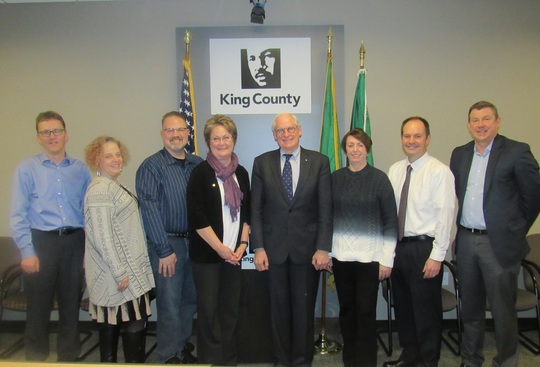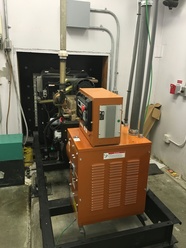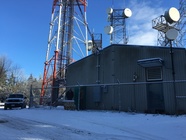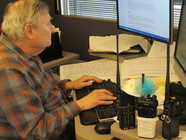 Beautiful shot heading up to Squak Mountain radio site.
I’m happy to announce that 2017 has started off with a bang for the PSERN Project. Amidst bad weather, winter storms, snow and rain we managed to make great strides!
To date, we have completed two radio sites—Federal Way and Crista and we have one more near completion—Top Hat. All of these sites have had a variety of work done including electrical, shelter upgrades and HVAC work. Most recently, we finished a tower extension at the Regional Communications and Emergency Coordination Center (RCECC) which was the first of a few to come. Upcoming site development work will take place at Norway Hill where we will be installing a brand new tower and shelter.
As you can imagine on a project of this magnitude, there are many documents to manage, create and review. While construction crews are busy building sites, our team back at the office is busy reviewing the latest Motorola deliverables. We are currently reviewing deliverable group #5. Each group has a variety of documents (ie. designs, test plans, backhaul equipment plans etc.) that our team needs to approve prior to the Motorola moving ahead with plans.
The PSERN Project team continues to work fast and furious to keep the project moving forward despite the many challenges and obstacles that we are faced with throughout. I am very proud of the work we have accomplished so far and looking forward to delivering a brand new emergency radio system to our region.
-David Mendel, PSERN Director
|
|
 |
The PSERN Joint Board governs the PSERN Project and is made up of each of the four partners--City of Seattle, King County, Valley Communications (ValleyCom) and Eastside Public Safety Communications Agency (EPSCA). The Board meets once a month every 4th Thursday and they are responsible for adopting
and amending policies, business rules,
procedures, standards and guidelines related the PSERN Project. In the event a Joint Board member can't make a meeting, they each have an alternate to sit in their place for that meeting.
 PSERN Joint Board Members and Alternates from left to right: Mark Schmidt (A), Patti DeFazio (JB), Chris Elwell (JB), Lora Ueland (JB), Fred Jarrett (JB-Chair), Sharon Potts (A), Kurt Triplett (JB) and Bill Kehoe (JB). Not Pictured: John Vinson (JB) and Jane Christenson (A) and Kristin Meitzler (A). Photo Credit: Karla Clark, PSERN Project.
 PROJECT BUZZ.........
|
Tower extension at the King County Emergency Management Center (RCECC). If you look closely you will see two of the workers inside the red circle. Ric Meyers, KC Radio Communications Services
For those who may be new to the newsletter or just learning about the project here is a quick review!
The Puget Sound Emergency Radio Network (PSERN) is in progress and construction has begun on several radio sites throughout the County.
Currently, first responders use the King County Emergency Radio Communications System to coordinate activities at emergency events, communicate with each other and with their supervisors directing response activities. However this system is over 20 years old and is in danger of failing if it isn’t replaced. PSERN will replace the existing system with a brand new one.
There is a lot of work that will go into building the new radio system including electrical work, building and upgrading shelters to house equipment, building new towers and extending or upgrading existing ones and much more. So far, the PSERN Project has completed two radio sites—Federal Way and Crista and are currently doing electrical work and shelter upgrades at Squak Mountain and Top Hat.
Recently, the Project did a tower extension at King County’s Regional Communication and Emergency Coordination Center (RCECC). Tower extensions are typically done in order for the microwave paths to be able to reach each other, we have to make sure the radio tower is tall enough to clear buildings, trees and terrain. In some cases, an entire new tower needs to be placed where there isn’t one already or to upgrade an existing one such as the tower replacement that will take place at Norway Hill soon.
Over the years, the population throughout the County has steadily increased and residents are living in regions they didn’t before which creates coverage challenges for the current system. PSERN will provide better Coverage, Capacity, Capability and Connectivity so that first responders will have reliable radio communications to do their jobs effectively and efficiently.
 The PSERN Project team is excited to begin work on the very first tower replacement! Shovels will hit the ground at the Norway Hill radio site in the next couple weeks. The existing 120 ft tower is quite old so it will be replaced with a brand new one as part of this extensive project. (Photo Credit Sean Douglas, PSERN Project)
|
 |
|
Old generator at the Squak Mountain radio site being upgraded for more power! (Photo Credit John Wright, PSERN Project)
|
This is an example of inside a shelter where the new radio equipment will be stored. The new equipment is smaller and more efficient! (Photo Credit John Wright, PSERN Project) |
|
 |
 |
|
Here is a glimpse at the outside of the shelter at Squak Mountain. The snow up there can get as high as 18 inches some winters! (Photo Credit John Wright, PSERN Project) |
 PSERN Tech guru Sparky (blue hair) hanging out with his favorite person, King County Information Technology (KCIT) CIO Bill Kehoe.
Hola fellow Technoids,
Time to bring you up to date on some happenings around here. Let’s talk about Fiber Optics. What is that you say? (for my non-geeky friends) Welp this means that PSERN will be leveraging the existing King County and City of Seattle Fiber Optic Networks for some dispatch locations.
While the bulk of the network traffic will be carried by point to point microwave, certain dispatch locations present an interesting challenge. Point to Point Microwave relies on line of site and is very similar to the way a flashlight works. For the light to be seen over a distance there cannot be any physical obstructions, like a wall or a door.
One of the challenges of dispatch centers in an urban environment is to have a clear line of site between two points. It’s sometimes very difficult to find an unobstructed path between two points due to the tall buildings and hills around here. Another potential issue is the construction of a new building in one of our paths after our network has been completed.
A new building could potentially make the path unusable. So Fiber Optics becomes the choice in certain areas. Working with King County and Seattle has enabled us to use existing fiber optic cables to provide the connectivity to those locations that might not have Microwave paths available.
Rumor has it the Snoqualmie Pass Ski area is open until 10 tonight. Just might have to do some more site walks….
 |
|
PSERN Lead Project Manager Hai Phung keeps a smile on his face no matter what challenges come up on a very complex project like PSERN. Here, the PSERN Mascots are helping him review Motorola deliverables. He managed to convince them to take a break and say cheese for the camera. |
On the rare occasions PSERN Construction Manager Bob Gruhn is at his desk and not at a radio site, the PSERN Mascots help him with radio site construction planning. |
|
 |
 |
|
Leases, leases and yep more leases! The PSERN Mascots intently help PSERN Government Relations Manager Marlin Blizinsky read through several leases. If you haven't guessed by now, leases are a crucial part of the Project! |
Did You Know?
Your typical "D" size battery is rated for 1.5 Volts and 8 Amp hours. Some of the PSERN site battery plants will be rated for 48 Volts and as much as 8000 Amp hours!
|
|
 |
|